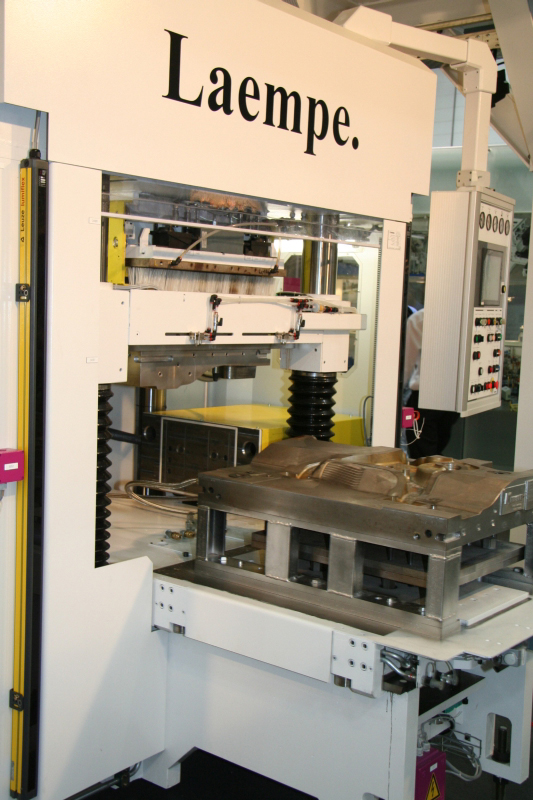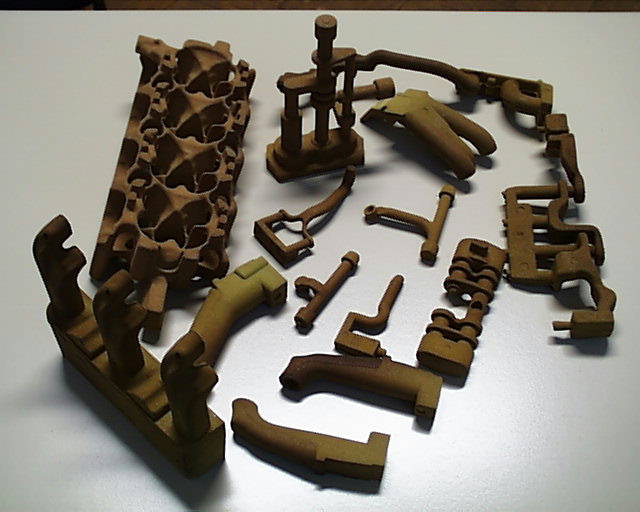Hot-box process
Process for making cores out of moist, organically bound, bulk or shootable mold materials hardened in hot metal core boxes on corresponding core shooting machines (Fig.1).
The stored heat absorbed in this core making process results in complete hardening of the core.This process enables the production of cores of high or very high complexity since flowability and thus shaping accuracy are very high (Fig. 2, Hüttenes-Albertus Chemische Werke GmbH). Basically, all casting materials can be used; however, light-metal alloys may present problems relating to decomposition of the core upon casting.The most significant disadvantages of this process are the high energy demand, inflexible core making (batch size, core volume, core shape) and high tooling and mold material costs. Moreover, it is difficult to make cores of variable wall thicknesses.
The production sequence of this process can be described as follows:
1. Preparation of the mold material (dry quartz sand is used as the basic mold material, mixed with a hot-setting synthetic resin binder and supplemented with a hardener or catalyst)
2. Transport of the mold material to the core shooting machine
3. Shooting of the mold material into the preheated core box
4. Hardening of the mold material in contact with the hot tool
5. Removal of the core and post-hardening of the core mold material, in particular in the core center, by the heat absorbed until its final strength is reached
The selection of the binder is mainly dependent on the casting material and has to take into account thermal stability and subsequent decomposition properties.
The hot-box processes has very high demands concerning the quality of the quartz sand. In particular, the percentage of alkalis and the clay content need to be as low as possible.
The type of binder and the binder content not only determine the hardening conditions but also the mold material properties that can be achieved.
Gas extraction from hot-box cores is of particular importance for organically bound mold materials since the binders largely decompose under the casting conditions. Pyrolysis (i.e. the decomposition of binders due to heat) generates breakdown products from the binder components, such as hydrogen, carbon monoxide, methane, carbon dioxide, nitrogen and higher-order hydrocarbons. The resulting core gases have to be extracted by means of particularly effective measures. Ideally, they are extracted via the core prints.
The dynamics of gas evolution have a significant impact on the tendency towards defects. Hot-box binders based on phenolic resin show a favorable gas evolution behavior. In addition, this process involves a relatively low binder content, ensuring good permeability to gas which also reduces the tendency towards defects.
The hardening of hot-box cores is carried out in metal core boxes. The heating elements are integrated into the core boxes. Direct heating can be accomplished using electric hot plates or gas-fired hot plates. Generally, electrical core box heating is preferred for small cores. What is important is that the core box is completely enclosed in order to evenly supply heat to the core. If the core box equipment includes a recess (mandrel) or a larger core box bottom, these are separately heated by means of integrated cartridge heaters.
The core box equipment for large cores is often directly fitted with heating resistors. This is done by integrating cartridge heaters or flexible tubular heaters. Gas heaters prevail with very large cores and core boxes as they allow for more cost-efficient equipment and easier maintenance and repair. Here, heating only occurs via hot plates, transferring their heat to the core box parts during hardening.
Ensuring an even temperature in all parts of the core box is essential in order to achieve rapid and above all even and full hardening. This requirement is particularly difficult to meet with large and geometrically complex core boxes.



